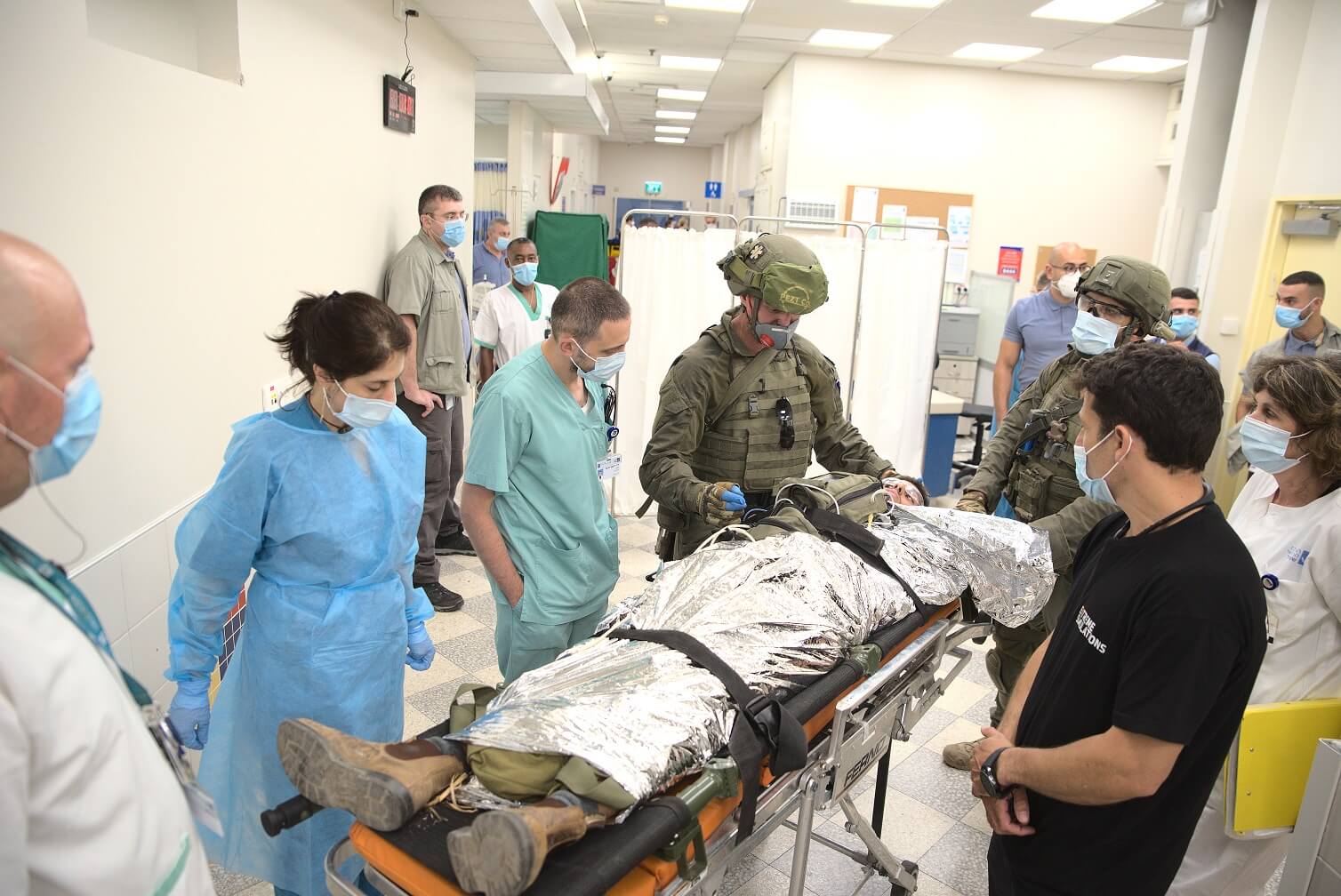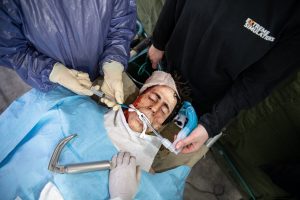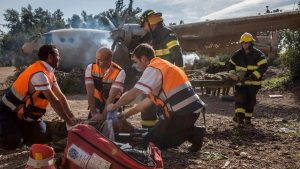You may be wondering why, at Extreme Simulations, we practice different steps in handling multiple casualty incidents and correlate them from the first minute of the rescue mission up to hospitalization.
Loss of information due to separate trainings within an organization
In an organization, different sections of the organization take part in trainings separately and not as a whole.
What is more, organizations that are meant to collaborate in case of an extreme incident are also training separately.
This makes them unaware of the problems that arise in the interfaces between the sections or organizations.
Analyzing true events instead of learning from exercises alone teaches us that there is a gap in conveying relevant information about the victims in the various stages of treatment and evacuation, inside and outside the hospital.
The problem grows as the operational difficulties increase (such as difficult terrain, rescues, enemy) and as the number of casualties increases.
The problem concerns not only the aspect of medical care but also many non-medical aspects, such as the ability to provide information to the families of the victims.
A story of an information transfer error leading to poor soldier treatment
Two injured soldiers were evacuated to the same hospital during an operational incident.
The forces on the ground were aware of both casualties, including their names. At this stage, the two sounded soldiers were given prehospital medical treatment, including drugs.
The soldiers were then evacuated from the scene of the incident by an evacuation unit.
A helicopter then took them from the evacuation point to the hospital.
At each stage of this transfer, more and more information about the wounded soldiers was lost. The state of urgency led to information being poorly documented, so much so that, upon the soldiers’ arrival at the hospital, no one knew who was who of the two.
Even more concerning was that the medical staff did not have access to any information regarding the soldiers’ previous treatments (such as drugs, anamnesis, and ext). You can imagine how such a situation would make it difficult for the hospital staff to treat the wounded. Loss of such information can lead to poor treatment and increases the chances of medical errors.
But beyond the medical challenges, passing the information over to the soldiers’ families was practically impossible. They had heard the news about the incident and were waiting for information on their health.
However, no one could tell them about the medical condition of their loved ones…
What causes problems in transferring information?
Below is a selection of the problems and difficulties in transmitting information, as well as solutions we, at Extreme Simulations, are familiar with. We can help organizations improve their performance in these areas to visibly enhance medical and operational care.

Problem: in a multi-casualty incident, the documentation is pushed aside
Medical staff (which is a bottleneck) is busy administering treatment to the wounded and does not deal with documentation. This is understandable, as the medical staff is always trying – especially in a multi-casualty event – to give maximum care as quickly as possible.
Physicians and paramedics are busy performing life-saving procedures, alongside constant prioritization and event management.
However, when registration procedures are not sufficiently assimilated, the registration is pushed aside, and sometimes out.
Problem: The phenomenon of “shouting in the air”
What we often see during training exercises is that medical professionals distribute instructions for performing procedures, administering medications, and so on.
The instructions are thrown in the air, but no one knows who should implement them or if they are performed at all.
Problem: Lack of a connection between the wounded – the story, and difficulty in identifying the wounded
We were talking about the instructions being thrown in the air – but even when they are documented, very often the documentation is separated from the patient.
Once that happens, there is no way to reconnect the documentation papers to the patient. There are situations when people have similar names, so even when you manage to find a list of the wounded and check their treatment, it may still not be clear who is who because of the name similarities.
Problem: Shortness of time and urgency
Imagine you are in an extreme situation; you have to save someone and you have to do it fast. This leads to extreme stress and involuntary prioritization of procedures. Especially in a dangerous area, you may forget to update the rescue team about the patient’s status or treatment because all you can think about is how to get them out FAST.

Problem: Loading on noisy tools
Many evacuation vehicles (especially the military and especially helicopters) are very noisy, and so information transmitted orally is distorted and changed.
Problem: Lack of common language regarding the injured in a multi-casualty incident
You’re talking about patient A, while your colleague is talking about patient B, all the while both of you think you’re talking about the same patient.
This happens when the wounded are not marked.
Speaking of marking, another mistake that can occur is to call the injured by their diagnosis. For example, referring to a patient as “the one with scratches on their hands” is incorrect and dangerous, as it establishes a diagnosis (most often incomplete) and may cause no further tests to be performed.

Problem: Difficulty of computerized systems to receive anonymous patients
Hospital systems are based on the name reception of a wounded person.
Many times, the absorption of an anonymous person creates difficulty.
We see hospitals struggling to absorb a large number of anonymous wounded. This creates difficulty in removing stickers, difficulty in absorbing systems, and performing parallel operations outside the systems. Even setting a schedule for feeding the wounded and choosing their menu can be a challenge when we’re talking about multiple anonymous patients.

Problem: Lack of sufficient training, especially in transferring an injured person from level to level
The common procedure is to perform training sessions for each department separately or for each team separately.
This is a mistake.
The problem of the loss of information occurs because remote parts of an organization have to work together in an environment they are not familiar with, under extreme stress and unique circumstances.
Inter-organizational exercises are a rarity. The interfaces between field care, evacuation, and hospitals are hardly ever practiced.
Five solutions to avoid loss of information in multiple casualty incidents
One thing that is always true is that in every event there IS someone in charge of the medical records (regardless of whether or not there is also an advanced digital system).

The solution starts with awareness.
In this case, the solution is mainly related to proper organizational conduct.
The process of finding solutions is best to be identified by the trainees. This is possible as a result of quality practice/training (in other words, training that best simulates a real event). The training session should include a set of different scenarios if-this-then-that; a maximum number of combinations should be set to consider all the things that might go wrong during a real-life event.
Additionally, other solutions include:
- Installing an information transfer format that everyone is familiar with and that is devoutly performed. For example: recording a summary or marking and confirming the execution of instructions.
- Even when you are in a hurry, you must keep your focus. At every stage of a procedure, stop for a second and organize your actions, document your decisions. Napoleon once told his dresser, “I’m in a hurry, so dress me slowly.” When you are in a hurry and stressed, work in a calm and orderly manner. Do NOT skip procedural steps, as you may be putting someone’s life in danger.
- When a wounded person is evacuated, a document should be attached to that person. This can be done by using a handcuff or something similar that will not fall on the road, will not be damaged or erased regardless of the means of transport for the evacuation mission (helicopter, ship or tank).
- In multi-casualty events, during the triage, numbers are written on the injured, and they become the “name tags” for these patients until they get to a hospital and get their own stickers.
- Training hospitals in multi-casualty events using a lot of anonymous stickers and making sure the entire hospital staff knows how to work with them.
Request a quote for a multiple casualty incident training now
GET IN TOUCH
Contact Extreme Simulations now to book a complete training session





